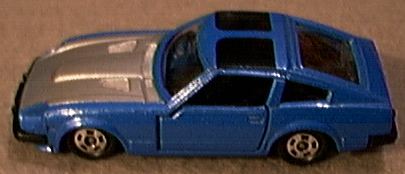 Tomica 15-C Nissan Fairlady 280Z-T 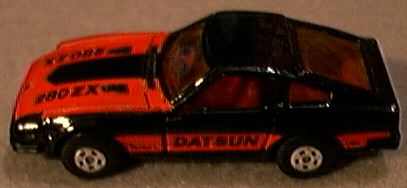 Matchbox 5 and 78 Datsun 280ZX 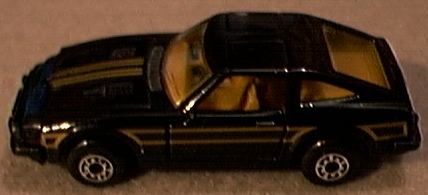 Matchbox 24 Datsun 280ZX 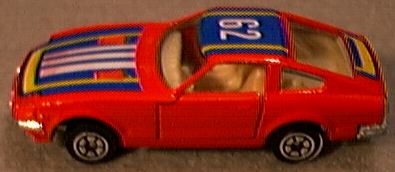 Yatming 1062 Datsun 280ZX 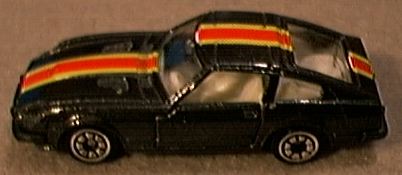 Speed Wheels Datsun 280ZX 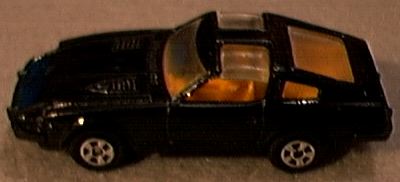 Ertl Datsun 280ZX 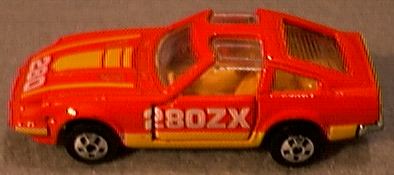 Road Champs Datsun 280ZX  Johnny Lightning Datsun 280ZX (1981) 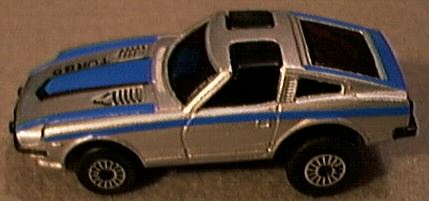 Zylmex Datsun 280ZX 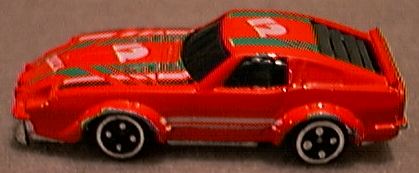 Summer Datsun 280ZX #S8562F (Editor's note: I had to borrow this car from my 5 year-old son who asked, "What is it?") Not Shown: Kidco 16000-4 Datsun 280ZX |
The less-than Fairlady: Nissan's 280ZX The concept behind and the execution of the new ZX was decidedly different from that of the original Z-car platform. Nissan knew that the market had changed dramatically since the 240Z was introduced (after all, the original Z was the car responsible for all the change) and that the competition was readily catching up to its then current 260 and 280 models. Furthermore, as the base price of the Z car increased, the average age of its buyers did likewise; obviously, this logically meant that the pure, uncompromised sports car approach was probably a bit off target for customers who were now married and had children. In the end, Nissan boldly moved the Z's replacement away from its past and into a future that would center around the new ZX being a luxurious gran turismo. At first glance, the ZX didn't appear all that strikingly different from its predecessor as Nissan deliberately retained a considerable number of the earlier Z's trademark styling cues. Nevertheless, the ZX was a completely new and much larger chassis that dispensed with the original Z's rear Chapman struts in favor of a more conventional semi-trailing arm rear suspension system. The interior layout also borrowed heavily from the "look" established by the earlier Z yet now featured considerably more expensive trimmings and a myriad of gadgets that would have made James Bond envious. While braking was up rated to four-wheel discs all around, the drive train remained, somewhat curiously, the same 2.8 litre straight six with five-speed gearbox as that found in the previous 280Z. Needless to say, performance of the old six (an ancestor of which had once propelled the 240Z so quickly) suffered heavily due to the new car's additional weight. Nonetheless, the new car was still seen as a desirable package by many and sales started off and remained strong throughout its production life. However, the 280ZX was not a static creation and by 1979, Nissan addressed the complaints of the car's lack of power by installing a turbocharger that largely restored its reputation. Yet the 280ZX was not to enjoy as long of a production life as its predecessor and after six years and several sales records, the car was gave way to the entirely new 300ZX. The 300ZX was the first Z car to carry a V6 engine and to most, it signaled with its ugly (and quickly dated) styling the end of the classic Z car era. Not surprisingly and especially when considering its sales success, the 280ZX became an extremely popular subject in the world of diecast cars with many companies producing miniatures. In fact, it's somewhat more interesting to note which model car companies didn't make ZXs than to seek out those that did. With that in mind, let's survey the ZX in 1:64 scale. Although Tomica has often been overlooked by collectors outside of the Orient due to it's focus on Japanese cars, certain models it has produced are widely coveted. Among Tomy's most popular miniatures are any of the Nissan Z cars, including its outstanding 280ZX. Perhaps the most accurate small scale model of this car ever produced, the Tomica ZX has opening doors, perfectly sized wheels and, as with all Tomicas, excellent paint work. While collectors quickly grab up the standard road-going version of this model, a rarer variation wearing a roof-mounted light bar and decorated in the standard Japanese police livery of black and white occasionally turns up to add a little more variety to a ZX collection. By the late 1970s, skyrocketing production costs in England were sinking Matchbox's parent company of Lesney into a morass financial difficulty that eventually forced it to commission Universal to produce several of its models in Hong Kong. Among the Hong Kong Matchbox cars was a set of four Japanese sporting cars that included the new 280ZX from Nissan. The model captured the low-slung look of the ZX quite well and even the model's nose (a difficult aspect of the car to recreate in miniature) was almost perfect. Featuring opening doors and a nicely detailed interior, the model's quality of construction and paint work easily rivaled that of English-made Matchboxes and perhaps even exceeded them. In an interesting twist of fate, Universal acquired the troubled Lesney's assets and completely took over the production of Matchbox toys. In 1983, an entirely new casting of the 280ZX appeared under the Matchbox name and while it may superficially look the same as the old casting, this new model was based on the 280ZX 2+2 as opposed to the earlier 2-seater. As with its predecessor, the new model featured opening doors yet was unfortunately plagued by a variety of accuracy problems including oversized wheels, overly wide tracks and a high-off-the-ground stance that would have been more appropriate for a rally car. Also suffering from the same "rally car" affliction is Yatming's 280ZX. Otherwise a nice model with a well-sculpted interior and opening doors, this model is often found in garish paint schemes that do little to enhance the miniature's generally good lines. Earlier versions seem to have the most reserved paint work than later versions; however, later versions did acquire smaller diameter wheels which help to somewhat alleviate the "jacked up" appearance of the earlier models. Usually associated with the Walgreens drugstore chain they are sold at, the Speed Wheels brand consists of mostly pirated castings based on a number of other manufacturer's models. However, some Speed Wheels castings appear to be made using dies retired by other companies. One such example of this is Speed Wheels' 280ZX which seems to be a discarded Yatming (Editor's note: Perhaps a Tomica copy?). A popular option on the 280ZX was the "T-Top" roof with its two removable glass panels above the driver's and passenger's seats. With so many U.S.-bound ZXs being equipped with the T-Top, it only seems appropriate that two U.S.-based toy makers would offer models of the T-Top ZX. Often paid little attention to, Ertl's 1:64 scale model of the mid to late 1970s and early 1980s demanded much more respect than what they received. A particularly well-done miniature in the series was the Datsun 280ZX. Unfortunately scarce today, it remains a model worth obtaining for your Z-car collection. Another company whose 1:64 products met with little success was Road Champs. Today widely known for its popular line of 1:43 scale American police cars, the 1:64 series help to establish the manufacturer as a force within the marketplace. Frequently painted in fluorescent colors that did little to enhance the models, most of these largely forgotten models were well-made and accurate. Another infrequently remembered line of diecast cars from the late 1970s is the Kidco brand. Although some of their models were dull models of mundane cars such as the Chevrolet Chevette, Kidco's two Z car castings were both worthy miniatures. Of special note was a limited edition 280ZX celebrating the Z car's tenth anniversary. With opening doors and a unique though not outrageous paint scheme that mixed gold and black, this model was well-proportioned and nicely detailed. Of course, the catch is that this model is today a very rare find. Explaining why certain models are made while others are neglected is a formidable task. With this in mind, one has to question why Playing Mantis would choose to produce a miniature of the dubiously regarded 280ZX rather than the accepted classic 240Z in its Johnny Lightning line-up. Perhaps a license to use the 280ZX's likeness is much more easily acquired from Nissan than permission to replicate the 240Z; whatever the reason, Johnny Lightning's recently introduced 280ZX is something of a mystery. A model with no operating features, it compensates with an accurate body shape that is complemented by a very high quality finish. Though look at those wheels! JL does a great job on this model and then ruins the entire effect by installing considerably larger wheels on the rear axle! Other models in the same series as the ZX aren't afflicted with this "hopped up" nonsense and the 280 shouldn't be either. Are you listening JL? Perhaps Johnny Lightning got their idea from Zylmex's ZX and its obscenely large rear wheels. Always overlooked as inaccurate and inexpensive toy cars, some of Zylmex's models are quite good; however, this featureless miniature with its blacked-out windows epitomizes what often did go wrong with this series of little cars. Although completists will want to get this model for their collection, it's not the best place to start with ZXs. While on the subject of ruined models, it would be hard to overlook Summer's simply hideous 280ZX. A painfully cheap and charmless model with no interior, woefully inaccurate lines, misplaced axles and blanked off rear side windows, this miniature could easily be taken as a parody of the actual car. Be forewarned if you go looking for this model for your collection: you may not even recognize that it is supposed to be a ZX at first glance. And here we end our continuing survey of the most popular sports car ever made. Watch for future installments to highlight the two very different cars to wear the 300ZX nameplate. |